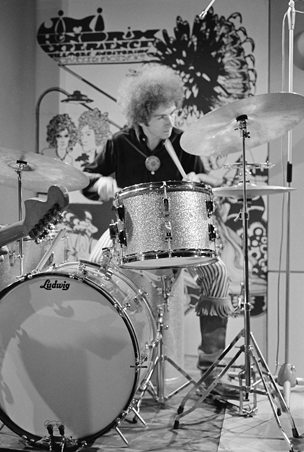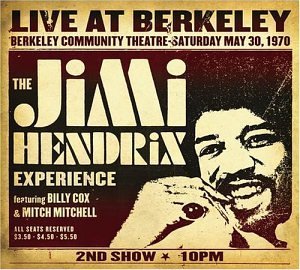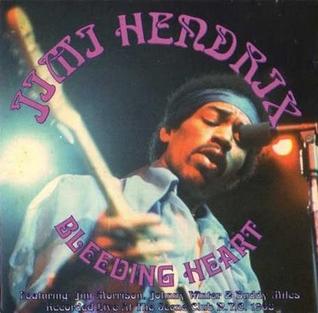Related Research Articles

James Marshall "Jimi" Hendrix was an American guitarist, songwriter and singer. Although his mainstream career spanned only four years, he is widely regarded as one of the greatest and most influential electric guitarists in the history of popular music, and one of the most celebrated musicians of the 20th century. The Rock and Roll Hall of Fame describes him as "arguably the greatest instrumentalist in the history of rock music."

John Graham "Mitch" Mitchell was an English drummer and child actor, who was best known for his work in the Jimi Hendrix Experience for which he was inducted into the Rock and Roll Hall of Fame in 1992. He was inducted into the Modern Drummer Hall of Fame in 2009.

Electric Ladyland is the third and final studio album by the Jimi Hendrix Experience, released before Hendrix's death in 1970. A double album, it was the only record from the Experience with production solely credited to Hendrix. The band's most commercially successful release and its only number one album, it was released by Reprise Records in the United States on October 16, 1968, and by Track Records in the UK nine days later. By mid-November, it had reached number 1 on the U.S. charts, spending two weeks there. In the UK it peaked at number 6, where it spent 12 weeks on the chart.

Are You Experienced is the debut studio album by the Jimi Hendrix Experience. Released in 1967, the LP was an immediate critical and commercial success, and it is widely regarded as one of the greatest albums of all time. The album features Jimi Hendrix's innovative approach to songwriting and electric guitar playing which soon established a new direction in psychedelic and rock music as a whole music.

Axis: Bold as Love is the second studio album by the Jimi Hendrix Experience. It was first released by Track Records in the United Kingdom on December 1, 1967, only seven months after the release of the group's highly successful debut, Are You Experienced. In the United States, Reprise Records delayed the release until the following month. The album reached the top ten in the album charts in both countries.
"Little Wing" is a song written by Jimi Hendrix and recorded by the Jimi Hendrix Experience in 1967. It is a slower tempo, rhythm and blues-inspired ballad featuring Hendrix's vocal and guitar with recording studio effects accompanied by bass, drums, and glockenspiel. Lyrically, it is one of several of his songs that reference an idealized feminine or guardian angel-like figure. At about two and a half minutes in length, it is one of his most concise and melodically focused pieces.

Band of Gypsys is a live album by Jimi Hendrix and the first without his original group, the Jimi Hendrix Experience. It was recorded on January 1, 1970, at the Fillmore East in New York City with Billy Cox on bass and Buddy Miles on drums, frequently referred to as the Band of Gypsys. The album mixes funk and rhythm and blues elements with hard rock and jamming, an approach which later became the basis of funk rock. It contains previously unreleased songs and was the last full-length Hendrix album released before his death.
"Red House" is a song written by Jimi Hendrix and one of the first songs recorded in 1966 by the Jimi Hendrix Experience. It has the musical form of a conventional twelve-bar blues and features Hendrix's guitar playing. He developed the song prior to forming the Experience and was inspired by earlier blues songs.
"Voodoo Chile" is a song written by Jimi Hendrix and recorded in 1968 for the third Jimi Hendrix Experience album Electric Ladyland. It is based on the Muddy Waters blues song "Rollin' Stone", but with original lyrics and music. At 15 minutes, it is Hendrix's longest studio recording and features additional musicians in what has been described as a studio jam.

"Voodoo Child (Slight Return)" is a song recorded by the Jimi Hendrix Experience in 1968 that appears as the final track on the Electric Ladyland album released that year. It contains improvised guitar and a vocal from Jimi Hendrix, backed by Noel Redding on bass and Mitch Mitchell on drums. The song is one of Hendrix's best known; it was a feature of his concert performances throughout his career, and several live renditions were recorded and released on later albums.

Lucy O'Brien is a British author and journalist whose work focuses on women in music.

Live at Berkeley is a live album by American rock musician Jimi Hendrix. It documents his second performance at the Berkeley Community Theatre on May 30, 1970, and was released by MCA Records on September 16, 2003.
Barney Hoskyns is a British music critic and editorial director of the online music journalism archive Rock's Backpages.
"Third Stone from the Sun" is a mostly instrumental composition by American musician Jimi Hendrix. It incorporates several musical approaches, including jazz and psychedelic rock, with brief spoken passages. The title reflects Hendrix's interest in science fiction and is a reference to Earth in its position as the third planet away from the sun in the solar system.

Voodoo Soup is a posthumous compilation album by American rock musician Jimi Hendrix, released in the United States on April 11, 1995, by MCA Records. It was one of the last Hendrix albums produced by Alan Douglas, who was also responsible for the posthumous Hendrix releases Midnight Lightning and Crash Landing in 1975.

Bleeding Heart is one of several names given to albums of a 1968 jam session with Jimi Hendrix, Jim Morrison, and others. The albums were fashioned from an informal two-track tape recording made by Hendrix which was subsequently stolen from his apartment. The jam took place at the Scene, a nightclub in New York City, and various dates and participants have been suggested. Although it presents a unique setting, critics and biographers have generally found fault with the sound quality and Morrison's performance.

"Dolly Dagger" is a song written and recorded by Jimi Hendrix. On October 9, 1971, it was released on the posthumous album Rainbow Bridge, followed by a single on October 23. Backed with a multi-tracked studio solo rendition of the "Star Spangled Banner", the single peaked at number 74 on the Billboard Hot 100, making it the last Hendrix single to appear on the main Billboard chart.

"Hear My Train A Comin'" is a blues-based song written by Jimi Hendrix. Lyrically, it was inspired by earlier American spirituals and blues songs which use a train metaphor to represent salvation. Hendrix recorded the song in live, studio, and impromptu settings several times between 1967 and 1970, but never completed it to his satisfaction.
"Night Bird Flying" is a rock song written by Jimi Hendrix. It is a complex piece with multiple guitar parts and reflects a variety of styles. Lyrically, Hendrix continues to explore an idealized feminine figure, as in his 1967 song "Little Wing".
"Hey Baby (New Rising Sun)" or simply "Hey Baby" is a song written and recorded by American musician Jimi Hendrix, from his second posthumous album Rainbow Bridge (1971). The song is a slower and more melodic piece, which features the prominent use of chorus- and tremolo-effects on guitar. Hendrix uses an idealized feminine figure that recurs in several of his lyrics. Commentators have seen the song as representative of his post-Band of Gypsys musical direction.
References
- 1 2 3 "Charles Shaar Murray at rock's backpages library" . Retrieved 26 May 2013.
- 1 2 "I was an Oz schoolkid". The Guardian. 2 August 2001. Retrieved 7 February 2011.
- ↑ "A tale of two rock critics". The Guardian. 20 October 2000. Retrieved 7 February 2011.
- ↑ "NME: Still rocking at 50". BBC. 24 February 2002. Retrieved 7 February 2011.
- ↑ "Jazz from Hell". BBC Radio 3. 12 June 2004. Retrieved 7 February 2011.
- ↑ Long, Pat (2012). The History of the NME: High Times and Low Lives at the World's Most Famous Music Magazine. Pavilion Books. ISBN 978-1-907554-77-3.